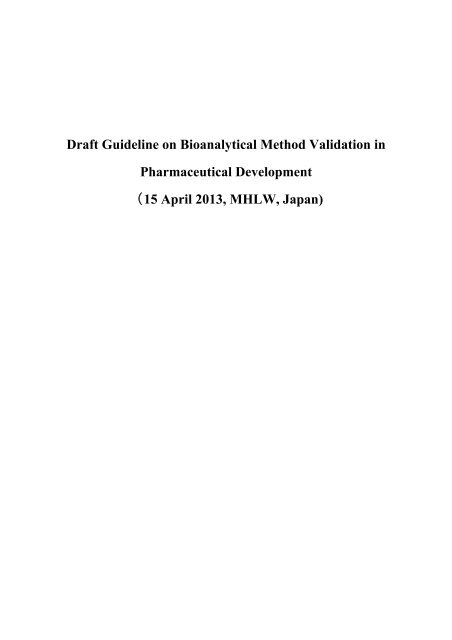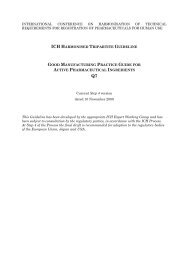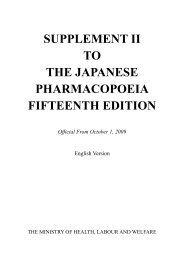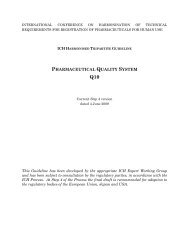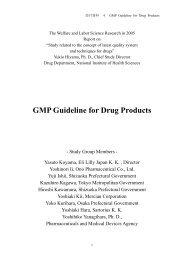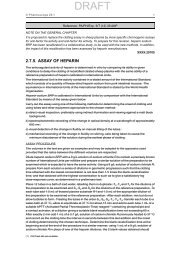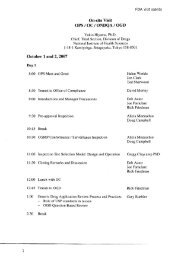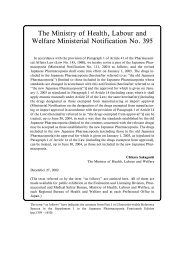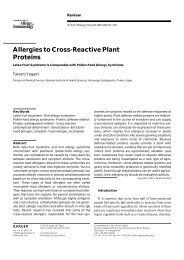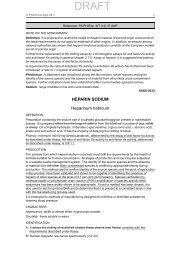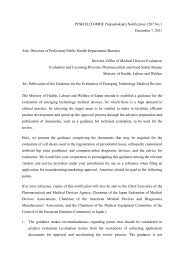Draft Guideline on Bioanalytical Method Validation in ... - NIHS
Draft Guideline on Bioanalytical Method Validation in ... - NIHS
Draft Guideline on Bioanalytical Method Validation in ... - NIHS
You also want an ePaper? Increase the reach of your titles
YUMPU automatically turns print PDFs into web optimized ePapers that Google loves.
<str<strong>on</strong>g>Draft</str<strong>on</strong>g> <str<strong>on</strong>g>Guidel<strong>in</strong>e</str<strong>on</strong>g> <strong>on</strong> <strong>Bioanalytical</strong> <strong>Method</strong> Validati<strong>on</strong> <strong>in</strong><br />
Pharmaceutical Development<br />
(15 April 2013, MHLW, Japan)
Table of C<strong>on</strong>tents<br />
1. Introducti<strong>on</strong><br />
2. Scope<br />
3. Reference Standard<br />
4. Analytical <strong>Method</strong> Validati<strong>on</strong><br />
4.1. Full validati<strong>on</strong><br />
4.1.1. Selectivity<br />
4.1.2. Lower limit of quantificati<strong>on</strong><br />
4.1.3. Calibrati<strong>on</strong> curve<br />
4.1.4. Accuracy and precisi<strong>on</strong><br />
4.1.5. Matrix effect<br />
4.1.6. Recovery<br />
4.1.7. Carry-over<br />
4.1.8. Diluti<strong>on</strong> <strong>in</strong>tegrity<br />
4.1.9. Stability<br />
4.2. Partial validati<strong>on</strong><br />
4.3. Cross validati<strong>on</strong><br />
5. Analysis of Study Samples<br />
5.1. Validity and reproducibility of analytical method <strong>in</strong> analysis of study samples<br />
5.1.1. Calibrati<strong>on</strong> curve<br />
5.1.2. QC samples<br />
5.1.3. Incurred samples reanalysis (ISR)<br />
5.1.4. Carry-over<br />
5.2. Po<strong>in</strong>ts to note<br />
5.2.1. Calibrati<strong>on</strong> range<br />
5.2.2. Reanalysis<br />
5.2.3. Chromatogram Integrati<strong>on</strong><br />
5.2.4. System suitability<br />
6. Documentati<strong>on</strong> and Archives <br />
List of Relevant <str<strong>on</strong>g>Guidel<strong>in</strong>e</str<strong>on</strong>g>s<br />
Glossary<br />
Annex<br />
2
1<br />
2<br />
3<br />
4<br />
5<br />
6<br />
7<br />
8<br />
9<br />
10<br />
11<br />
12<br />
13<br />
14<br />
15<br />
16<br />
17<br />
18<br />
19<br />
20<br />
21<br />
22<br />
23<br />
24<br />
25<br />
26<br />
27<br />
28<br />
29<br />
30<br />
31<br />
32<br />
33<br />
34<br />
35<br />
36<br />
1. Introducti<strong>on</strong><br />
In the development of medic<strong>in</strong>al products, bioanalytical methods are used <strong>in</strong> cl<strong>in</strong>ical<br />
and n<strong>on</strong>-cl<strong>in</strong>ical pharmacok<strong>in</strong>etic studies (<strong>in</strong>clud<strong>in</strong>g toxicok<strong>in</strong>etic studies) to evaluate<br />
the efficacy and safety of drugs and their metabolites. Drug c<strong>on</strong>centrati<strong>on</strong>s determ<strong>in</strong>ed<br />
<strong>in</strong> biological samples are used for the assessment of characteristics such as <strong>in</strong> vivo<br />
pharmacok<strong>in</strong>etics (adsorpti<strong>on</strong>, distributi<strong>on</strong>, metabolism, and excreti<strong>on</strong>), bioavailability,<br />
bioequivalence, and drug-drug <strong>in</strong>teracti<strong>on</strong>.<br />
It is important that these bioanalytical methods are well characterized throughout the<br />
analytical procedures to establish their validity, reproducibility, and reliability.<br />
This guidel<strong>in</strong>e serves as a general guidance recommended for the validati<strong>on</strong> of<br />
bioanalytical methods to ensure adequate reproducibility and reliability. It also provides<br />
a framework for analyses of study samples by us<strong>in</strong>g validated methods to evaluate study<br />
results support<strong>in</strong>g applicati<strong>on</strong>s for drug market<strong>in</strong>g authorizati<strong>on</strong>.<br />
An applicable way with flexible adjustment and modificati<strong>on</strong> should be required <strong>in</strong><br />
case of us<strong>in</strong>g the specific type analytical method or depend<strong>in</strong>g <strong>on</strong> the <strong>in</strong>tended use of<br />
the result of analysis, such as the use of prospectively def<strong>in</strong>ed appropriate criteria, based<br />
<strong>on</strong> scientific judgment.<br />
2. Scope<br />
This guidel<strong>in</strong>e is applicable to the validati<strong>on</strong> of analytical methods applied to<br />
measure c<strong>on</strong>centrati<strong>on</strong>s of drugs and their metabolites <strong>in</strong> biological samples obta<strong>in</strong>ed <strong>in</strong><br />
toxicok<strong>in</strong>etic studies and cl<strong>in</strong>ical trials, as well as to the analyses of study samples us<strong>in</strong>g<br />
such methods. The <strong>in</strong>formati<strong>on</strong> <strong>in</strong> this guidel<strong>in</strong>e generally applies to the quantificati<strong>on</strong><br />
of low-molecular-weight drugs and metabolites, and to analytical methods such as<br />
liquid chromatography (LC) and gas chromatography (GC) used either al<strong>on</strong>e or <strong>in</strong><br />
comb<strong>in</strong>ati<strong>on</strong> with mass spectrometry (MS).<br />
This guidel<strong>in</strong>e is not <strong>in</strong>tended for analytical methods used <strong>in</strong> n<strong>on</strong>-cl<strong>in</strong>ical studies that<br />
are bey<strong>on</strong>d the scope of "M<strong>in</strong>isterial Ord<strong>in</strong>ance C<strong>on</strong>cern<strong>in</strong>g the Standards for the<br />
C<strong>on</strong>duct of N<strong>on</strong>-cl<strong>in</strong>ical Studies <strong>on</strong> the Safety of Drugs (M<strong>in</strong>istry of Health and Welfare<br />
ord<strong>in</strong>ance No. 21, dated March 26, 1997)" but could be used as a reference <strong>in</strong><br />
c<strong>on</strong>duct<strong>in</strong>g a method validati<strong>on</strong>.<br />
3. Reference Standard<br />
3
37<br />
38<br />
39<br />
40<br />
41<br />
42<br />
43<br />
44<br />
45<br />
46<br />
47<br />
48<br />
49<br />
50<br />
51<br />
52<br />
53<br />
54<br />
55<br />
56<br />
57<br />
58<br />
59<br />
60<br />
61<br />
62<br />
63<br />
64<br />
65<br />
66<br />
67<br />
68<br />
69<br />
70<br />
71<br />
72<br />
Reference standard serves as the standard <strong>in</strong> quantify<strong>in</strong>g an analyte, and is ma<strong>in</strong>ly<br />
used to prepare calibrati<strong>on</strong> standards and quality-c<strong>on</strong>trol (QC) samples, which are<br />
samples spiked with a known c<strong>on</strong>centrati<strong>on</strong> of the analyte of <strong>in</strong>terest. The quality of the<br />
reference material is critical, as the quality affect measurement data. Therefore, a<br />
material of known chemical structure from an authenticated source should be used as a<br />
reference standard.. A certificate of analysis that provides <strong>in</strong>formati<strong>on</strong> <strong>on</strong> lot number,<br />
expirati<strong>on</strong> date, c<strong>on</strong>tent (purity), and storage c<strong>on</strong>diti<strong>on</strong>s should accompany the standard.<br />
A certificate of analysis is not necessarily required for an <strong>in</strong>ternal standard, but the lack<br />
of analytical <strong>in</strong>terference with the analyte should be dem<strong>on</strong>strated before use as the<br />
<strong>in</strong>ternal standard.<br />
4. Analytical <strong>Method</strong> Validati<strong>on</strong><br />
4.1. Full validati<strong>on</strong><br />
A full validati<strong>on</strong> should be performed when establish<strong>in</strong>g a new bioanalytical method<br />
for quantificati<strong>on</strong> of an analyte. A full validati<strong>on</strong> should also be c<strong>on</strong>sidered when a new<br />
analyte, such as a metabolite, is added to an exist<strong>in</strong>g, fully validated analytical method.<br />
A full validati<strong>on</strong> is also required when us<strong>in</strong>g an analytical method that has been<br />
published <strong>in</strong> the literature.<br />
The objective of full validati<strong>on</strong> is to dem<strong>on</strong>strate selectivity, lower limit of<br />
quantificati<strong>on</strong> (LLOQ), calibrati<strong>on</strong> curve, accuracy, precisi<strong>on</strong>, matrix effect, recovery,<br />
carry-over, diluti<strong>on</strong> <strong>in</strong>tegrity, and stability. Generally, a full validati<strong>on</strong> should be<br />
performed for each species and matrix (ma<strong>in</strong>ly plasma, serum, whole blood, or ur<strong>in</strong>e) to<br />
be analyzed.<br />
The matrix used <strong>in</strong> analytical validati<strong>on</strong> should be as close as possible to the <strong>in</strong>tended<br />
study samples, <strong>in</strong>clud<strong>in</strong>g anticoagulant and additives. When an analytical method is to<br />
be established for a matrix of limited availability (rare matrix, e.g., tissue, cerebrosp<strong>in</strong>al<br />
fluid, bile), <strong>on</strong>e may encounter a problematic situati<strong>on</strong> where a sufficient amount of<br />
matrix cannot be obta<strong>in</strong>ed from an adequate number of sources (subjects or animals). In<br />
such a case, a surrogate matrix may be used to prepare calibrati<strong>on</strong> standards and QC<br />
samples. However, the use of a surrogate matrix should be rigorously justtified <strong>in</strong> the<br />
course of establish<strong>in</strong>g the analytical method.<br />
4.1.1. Selectivity<br />
4
73<br />
74<br />
75<br />
76<br />
77<br />
78<br />
79<br />
80<br />
81<br />
82<br />
83<br />
84<br />
85<br />
86<br />
87<br />
88<br />
89<br />
90<br />
91<br />
92<br />
93<br />
94<br />
95<br />
96<br />
97<br />
98<br />
99<br />
100<br />
101<br />
102<br />
103<br />
104<br />
105<br />
106<br />
107<br />
108<br />
Selectivity is the ability of an analytical method to measure and differentiate the<br />
analyte and the <strong>in</strong>ternal standard <strong>in</strong> the presence of other comp<strong>on</strong>ents <strong>in</strong> samples.<br />
Selectivity is evaluated us<strong>in</strong>g blank samples (matrix samples processed without<br />
additi<strong>on</strong> of an analyte or <strong>in</strong>ternal standard) obta<strong>in</strong>ed from at least 6 <strong>in</strong>dividual sources.<br />
The absence of <strong>in</strong>terference with each analyte and <strong>in</strong>ternal standard should be c<strong>on</strong>firmed.<br />
In case the matrix is of limited availability, it may be acceptable to use matrix samples<br />
obta<strong>in</strong>ed from less than 6 sources.<br />
The evaluati<strong>on</strong> should dem<strong>on</strong>strate that no resp<strong>on</strong>se attributable to <strong>in</strong>terfer<strong>in</strong>g<br />
comp<strong>on</strong>ents is observed with the blank samples or that a resp<strong>on</strong>se attributable to<br />
<strong>in</strong>terfer<strong>in</strong>g comp<strong>on</strong>ents is not more than 20% of the resp<strong>on</strong>se <strong>in</strong> the lower limit of<br />
quantificati<strong>on</strong> (LLOQ) for the analyte and 5% of the <strong>in</strong>ternal standard.<br />
4.1.2. Lower limit of quantificati<strong>on</strong><br />
The lower limit of quantificati<strong>on</strong> (LLOQ) is the lowest c<strong>on</strong>centrati<strong>on</strong> of an analyte at<br />
which the analyte can be quantified with reliable accuracy and precisi<strong>on</strong>.<br />
The analyte resp<strong>on</strong>se at the LLOQ should be at least 5 times the resp<strong>on</strong>se of a blank<br />
sample. Mean accuracy and precisi<strong>on</strong> at the LLOQ should be with<strong>in</strong> ±20% of the<br />
nom<strong>in</strong>al (theoretical) c<strong>on</strong>centrati<strong>on</strong> and not more than 20%, respectively.<br />
4.1.3. Calibrati<strong>on</strong> curve<br />
A calibrati<strong>on</strong> curve dem<strong>on</strong>strates the relati<strong>on</strong>ship between the theoretical<br />
c<strong>on</strong>centrati<strong>on</strong> and the resp<strong>on</strong>se of the analyte.<br />
A calibrati<strong>on</strong> curve needs to be prepared for each analyte. The calibrati<strong>on</strong> curve<br />
should be prepared us<strong>in</strong>g the same matrix as the <strong>in</strong>tended study samples, whenever<br />
possible, by spik<strong>in</strong>g the blank matrix with known c<strong>on</strong>centrati<strong>on</strong>s of the analyte. A<br />
calibrati<strong>on</strong> curve should be generated with a blank sample, a zero sample (blank sample<br />
spiked with <strong>in</strong>ternal standard)), and at least 6 c<strong>on</strong>centrati<strong>on</strong> levels of calibrati<strong>on</strong><br />
standards, <strong>in</strong>clud<strong>in</strong>g an LLOQ sample. In general, the simplest model that adequately<br />
describes the c<strong>on</strong>centrati<strong>on</strong>-resp<strong>on</strong>se relati<strong>on</strong>ship should be used for regressi<strong>on</strong> equati<strong>on</strong><br />
and weight<strong>in</strong>g c<strong>on</strong>diti<strong>on</strong>s of the calibrati<strong>on</strong> curve. A multiple regressi<strong>on</strong> equati<strong>on</strong> may<br />
be used. Blank and zero samples should not be <strong>in</strong>cluded <strong>in</strong> the determ<strong>in</strong>ati<strong>on</strong> of the<br />
regressi<strong>on</strong> equati<strong>on</strong> for the calibrati<strong>on</strong> curve. The validati<strong>on</strong> report should <strong>in</strong>clude the<br />
regressi<strong>on</strong> equati<strong>on</strong> and correlati<strong>on</strong>/determ<strong>in</strong>ati<strong>on</strong> coefficient used.<br />
The accuracy of back calculated c<strong>on</strong>centrati<strong>on</strong>s of each calibrati<strong>on</strong> standard should be<br />
5
109<br />
110<br />
111<br />
112<br />
113<br />
114<br />
115<br />
116<br />
117<br />
118<br />
119<br />
120<br />
121<br />
122<br />
123<br />
124<br />
125<br />
126<br />
127<br />
128<br />
129<br />
130<br />
131<br />
132<br />
133<br />
134<br />
135<br />
136<br />
137<br />
138<br />
139<br />
140<br />
141<br />
142<br />
143<br />
144<br />
with<strong>in</strong> ±20% of the theoretical c<strong>on</strong>centrati<strong>on</strong> at the LLOQ, or ±15% at all other levels.<br />
At least 75% of the calibrati<strong>on</strong> standards, with a m<strong>in</strong>imum of 6 levels, <strong>in</strong>clud<strong>in</strong>g the<br />
LLOQ and the highest levels, should meet the above criteria.<br />
4.1.4. Accuracy and precisi<strong>on</strong><br />
Accuracy of an analytical method describes the degree of closeness between analyte<br />
c<strong>on</strong>centrati<strong>on</strong> determ<strong>in</strong>ed by the method and its theoretical c<strong>on</strong>centrati<strong>on</strong>. Precisi<strong>on</strong> of<br />
an analytical method describes variati<strong>on</strong> between <strong>in</strong>dividual c<strong>on</strong>centrati<strong>on</strong>s determ<strong>in</strong>ed<br />
<strong>in</strong> repeated measurements.<br />
Accuracy and precisi<strong>on</strong> are assessed by perform<strong>in</strong>g analysis with QC samples, i.e.,<br />
samples spiked with known amounts of the analyte. In the validati<strong>on</strong>, QC samples with<br />
a m<strong>in</strong>imum of 4 different c<strong>on</strong>centrati<strong>on</strong>s (LLOQ and low-, mid-, and high-levels) with<strong>in</strong><br />
the calibrati<strong>on</strong> range are prepared. The low-level should be with<strong>in</strong> 3 times the LLOQ,<br />
the mid-level is around the midpo<strong>in</strong>t <strong>on</strong> the calibrati<strong>on</strong> curve, and the high-level should<br />
be at least 75% of the upper limit of the calibrati<strong>on</strong> curve. With<strong>in</strong>-run accuracy and<br />
precisi<strong>on</strong> should be evaluated by replicate analysis of at least 5 times at each<br />
c<strong>on</strong>centrati<strong>on</strong> level <strong>in</strong> a s<strong>in</strong>gle analytical run. Between-run accuracy and precisi<strong>on</strong><br />
should be evaluated by the analysis <strong>in</strong> at least 3 analytical runs.<br />
The mean accuracy at each c<strong>on</strong>centrati<strong>on</strong> level should be with<strong>in</strong> ±15% of the<br />
theoretical c<strong>on</strong>centrati<strong>on</strong>, except at the LLOQ, where it should be with<strong>in</strong> ±20%.<br />
Precisi<strong>on</strong> of c<strong>on</strong>centrati<strong>on</strong>s determ<strong>in</strong>ed at each level should not exceed 15%, except at<br />
the LLOQ, where it should not exceed 20%.<br />
4.1.5. Matrix effect<br />
Matrix effect is an alterati<strong>on</strong> of the analyte resp<strong>on</strong>se due to matrix comp<strong>on</strong>ent(s) <strong>in</strong><br />
the sample. Matrix effect should be assessed when us<strong>in</strong>g mass spectrometric methods.<br />
Matrix effect is evaluated by calculat<strong>in</strong>g the matrix factor (MF). The MF is<br />
determ<strong>in</strong>ed by compar<strong>in</strong>g the analyte resp<strong>on</strong>se <strong>in</strong> the presence of matrix with that <strong>in</strong> the<br />
absence of matrix. MF should be calculated us<strong>in</strong>g matrix from at least 6 different<br />
sources. The MF may be normalized us<strong>in</strong>g an <strong>in</strong>ternal standard. The precisi<strong>on</strong> of the<br />
MF calculated should not exceed 15%.<br />
Matrix effect can also be evaluated by analyz<strong>in</strong>g QC samples, each prepared us<strong>in</strong>g<br />
matrix from at least 6 different sources. The precisi<strong>on</strong> of determ<strong>in</strong>ed c<strong>on</strong>centrati<strong>on</strong>s<br />
should not be greater than 15%.<br />
6
145<br />
146<br />
147<br />
148<br />
149<br />
150<br />
151<br />
152<br />
153<br />
154<br />
155<br />
156<br />
157<br />
158<br />
159<br />
160<br />
161<br />
162<br />
163<br />
164<br />
165<br />
166<br />
167<br />
168<br />
169<br />
170<br />
171<br />
172<br />
173<br />
174<br />
175<br />
176<br />
177<br />
178<br />
179<br />
180<br />
In case the matrix is of limited availability, it may be acceptable to use matrix<br />
obta<strong>in</strong>ed from less than 6 sources.<br />
4.1.6. Recovery<br />
Recovery is a measure of the efficiency at which an analytical method recovers the<br />
analyte through the sample-process<strong>in</strong>g step.<br />
The recovery is determ<strong>in</strong>ed by compar<strong>in</strong>g the analyte resp<strong>on</strong>se <strong>in</strong> a biological sample<br />
that was spiked with the analyte and processed, with the resp<strong>on</strong>se <strong>in</strong> a biological blank<br />
sample that was processed and then spiked with the analyte. Recovery is evaluated by<br />
replicate analysis of at least 3 times each at 3 c<strong>on</strong>centrati<strong>on</strong> levels (low-, mid-, and<br />
high-levels). It is important to dem<strong>on</strong>strate the reproducibility at each level, rather than<br />
to show a higher recovery rate.<br />
4.1.7. Carry-over<br />
Carry-over is an alterati<strong>on</strong> of the measured c<strong>on</strong>centrati<strong>on</strong> due to a leftover analyte <strong>in</strong><br />
the analytical <strong>in</strong>strument used.<br />
The carry-over should be evaluated by analyz<strong>in</strong>g a blank sample follow<strong>in</strong>g the<br />
highest c<strong>on</strong>centrati<strong>on</strong> calibrati<strong>on</strong> standard. The resp<strong>on</strong>se <strong>in</strong> the blank sample obta<strong>in</strong>ed<br />
after measurement of the highest c<strong>on</strong>centrati<strong>on</strong> standard should not be greater than 20%<br />
of the analyte resp<strong>on</strong>se at the LLOQ and 5% of the resp<strong>on</strong>se of <strong>in</strong>ternal standard.<br />
If these criteria cannot be met, the extent of carry-over needs to be exam<strong>in</strong>ed, and<br />
appropriate procedures should be taken to avoid any impact dur<strong>in</strong>g the analysis of actual<br />
study samples.<br />
4.1.8. Diluti<strong>on</strong> <strong>in</strong>tegrity<br />
If samples require diluti<strong>on</strong> before analysis, the diluti<strong>on</strong> procedure should be tested to<br />
c<strong>on</strong>firm the absence of any impact <strong>on</strong> the measured c<strong>on</strong>centrati<strong>on</strong> of the analyte.<br />
Diluti<strong>on</strong> <strong>in</strong>tegrity should be evaluated by the replicate analysis of at least 5 times per<br />
diluti<strong>on</strong> factor after dilut<strong>in</strong>g a sample with blank matrix to br<strong>in</strong>g the analyte<br />
c<strong>on</strong>centrati<strong>on</strong> with<strong>in</strong> the calibrati<strong>on</strong> range. Mean accuracy and precisi<strong>on</strong> <strong>in</strong> the<br />
measurements of diluted samples must be with<strong>in</strong> ±15% of the theoretical c<strong>on</strong>centrati<strong>on</strong><br />
and not more than 15%, respectively.<br />
If a different matrix is used for sample diluti<strong>on</strong>, the absence of impact <strong>on</strong> the<br />
7
181<br />
182<br />
183<br />
184<br />
185<br />
186<br />
187<br />
188<br />
189<br />
190<br />
191<br />
192<br />
193<br />
194<br />
195<br />
196<br />
197<br />
198<br />
199<br />
200<br />
201<br />
202<br />
203<br />
204<br />
205<br />
206<br />
207<br />
208<br />
209<br />
210<br />
211<br />
212<br />
213<br />
214<br />
215<br />
216<br />
accuracy and precisi<strong>on</strong> should be dem<strong>on</strong>strated <strong>in</strong> the same manner.<br />
4.1.9. Stability<br />
Analyte stability is evaluated to ensure that the analyte c<strong>on</strong>centrati<strong>on</strong> is not affected<br />
as the samples move through each step of the process from sample collecti<strong>on</strong> to f<strong>in</strong>al<br />
analysis. The stability of the samples should be assessed under c<strong>on</strong>diti<strong>on</strong>s that is as<br />
close as possible to those under which the samples are actually stored or analyzed.<br />
Careful c<strong>on</strong>siderati<strong>on</strong> should be given to the solvent or matrix type, c<strong>on</strong>ta<strong>in</strong>er materials,<br />
and storage c<strong>on</strong>diti<strong>on</strong>s used <strong>in</strong> the stability-determ<strong>in</strong>ati<strong>on</strong> process.<br />
Validati<strong>on</strong> studies should determ<strong>in</strong>e analyte stability after freeze and thaw cycles,<br />
after short-term (at room temperature, <strong>on</strong> ice, or under refrigerati<strong>on</strong>) and l<strong>on</strong>g-term<br />
storage; stability <strong>in</strong> the processed samples should also be c<strong>on</strong>sidered. All stability<br />
experiments should be performed <strong>on</strong> samples that have been stored for a time that is<br />
l<strong>on</strong>ger than the actual storage period.<br />
Stability of the analyte <strong>in</strong> the stock and work<strong>in</strong>g soluti<strong>on</strong>s is usually evaluated us<strong>in</strong>g<br />
soluti<strong>on</strong>s near the highest and lowest c<strong>on</strong>centrati<strong>on</strong> levels. The evaluati<strong>on</strong> is performed<br />
by replicate analysis of at least 3 times at each level.<br />
Stability of the analyte <strong>in</strong> the studied matrix is evaluated us<strong>in</strong>g low- and high-level<br />
QC samples. The QC samples should be prepared us<strong>in</strong>g a matrix that is as close as<br />
possible to the actual study samples, <strong>in</strong>clud<strong>in</strong>g anticoagulant and additives. Stability is<br />
evaluated by replicate analysis of at least 3 times per c<strong>on</strong>centrati<strong>on</strong> level with QC<br />
samples before and after storage. The mean accuracy <strong>in</strong> the measurements at each level<br />
should be with<strong>in</strong> ±15% of the theoretical c<strong>on</strong>centrati<strong>on</strong>, <strong>in</strong> pr<strong>in</strong>ciple.<br />
4.2. Partial validati<strong>on</strong><br />
Partial validati<strong>on</strong> may be performed when m<strong>in</strong>or changes are made to an analytical<br />
method that has already been fully validated. A set of parameters to be evaluated <strong>in</strong> a<br />
partial validati<strong>on</strong> are determ<strong>in</strong>ed accord<strong>in</strong>g to the extent and nature of the changes made<br />
to the method.<br />
Typical bioanalytical method changes that are subject to a partial validati<strong>on</strong> are as<br />
follows: analytical method transfers between laboratories, changes <strong>in</strong> analytical<br />
<strong>in</strong>struments, changes <strong>in</strong> calibrati<strong>on</strong> range, changes <strong>in</strong> sample volume used for analysis,<br />
changes <strong>in</strong> anticoagulant, changes <strong>in</strong> sample-process<strong>in</strong>g procedures or analytical<br />
c<strong>on</strong>diti<strong>on</strong>s, changes <strong>in</strong> sample storage c<strong>on</strong>diti<strong>on</strong>s, c<strong>on</strong>firmati<strong>on</strong> of impact by<br />
8
217<br />
218<br />
219<br />
220<br />
221<br />
222<br />
223<br />
224<br />
225<br />
226<br />
227<br />
228<br />
229<br />
230<br />
231<br />
232<br />
233<br />
234<br />
235<br />
236<br />
237<br />
238<br />
239<br />
240<br />
241<br />
242<br />
243<br />
244<br />
245<br />
246<br />
247<br />
248<br />
249<br />
250<br />
251<br />
252<br />
c<strong>on</strong>comitant drugs, and use of rare matrices. Changes <strong>in</strong> species and matrix may also<br />
fall <strong>in</strong>to this category.<br />
Acceptance criteria used <strong>in</strong> partial validati<strong>on</strong> should <strong>in</strong> pr<strong>in</strong>ciple be the same as those<br />
employed <strong>in</strong> the full validati<strong>on</strong>.<br />
4.3. Cross validati<strong>on</strong><br />
Cross validati<strong>on</strong> is primarily c<strong>on</strong>ducted when data are generated <strong>in</strong> multiple<br />
laboratories with<strong>in</strong> the same study or when compar<strong>in</strong>g analytical methods used <strong>in</strong><br />
different studies. In the cross validati<strong>on</strong> c<strong>on</strong>ducted after full or partial validati<strong>on</strong> <strong>in</strong> each<br />
laboratory or for each analytical method to be compared, the same set of QC samples<br />
spiked with the analyte or the same set of study samples is analyzed at both laboratories<br />
or by both analytical methods, and the mean accuracy at each c<strong>on</strong>centrati<strong>on</strong> level or the<br />
assay variability is evaluated.<br />
In the cross validati<strong>on</strong> between different laboratories with<strong>in</strong> the same study, the mean<br />
accuracy of QC samples (low-, mid-, and high-levels) at each level should be with<strong>in</strong><br />
±20% of the theoretical c<strong>on</strong>centrati<strong>on</strong>, c<strong>on</strong>sider<strong>in</strong>g the <strong>in</strong>termediate precisi<strong>on</strong> and<br />
reproducibility (<strong>in</strong>ter-laboratories precisi<strong>on</strong>). When us<strong>in</strong>g a set of study samples, the<br />
assay variability should be with<strong>in</strong> ±20% for at least two-thirds of the samples.<br />
In the cross validati<strong>on</strong> between different analytical methods, both validati<strong>on</strong><br />
procedure and acceptance criteria (i.e., acceptable assay variability) should be<br />
separately def<strong>in</strong>ed based <strong>on</strong> scientific judgment by c<strong>on</strong>sider<strong>in</strong>g the nature of the<br />
analytical methods.<br />
5. Analysis of Study Samples<br />
Study samples are biological specimens that are obta<strong>in</strong>ed from toxicok<strong>in</strong>etic studies<br />
and cl<strong>in</strong>ical trials for bioanalysis. Analysis of study samples should be carried out us<strong>in</strong>g<br />
an established analytical method that has been fully validated. In the analysis, study<br />
samples are handled under c<strong>on</strong>diti<strong>on</strong>s that have been validated for adequate stability,<br />
and analyzed with<strong>in</strong> a def<strong>in</strong>ed stability period, al<strong>on</strong>g with a blank sample, a zero sample,<br />
calibrati<strong>on</strong> standards at a m<strong>in</strong>imum of 6 c<strong>on</strong>centrati<strong>on</strong> levels, and QC samples.<br />
5.1. Validity and reproducibility of the analytical method <strong>in</strong> analysis of study samples<br />
Validity of the analytical method dur<strong>in</strong>g study sample analysis should be evaluated <strong>in</strong><br />
9
253<br />
254<br />
255<br />
256<br />
257<br />
258<br />
259<br />
260<br />
261<br />
262<br />
263<br />
264<br />
265<br />
266<br />
267<br />
268<br />
269<br />
270<br />
271<br />
272<br />
273<br />
274<br />
275<br />
276<br />
277<br />
278<br />
279<br />
280<br />
281<br />
282<br />
283<br />
284<br />
285<br />
286<br />
287<br />
288<br />
each analytical run by us<strong>in</strong>g the calibrati<strong>on</strong> curve and QC samples. In studies that use<br />
pharmacok<strong>in</strong>etic data as the primary endpo<strong>in</strong>t, reproducibility of the analytical method<br />
should be c<strong>on</strong>firmed for each representative study by different matrix by perform<strong>in</strong>g<br />
<strong>in</strong>curred sample reanalysis (ISR: reanalysis of <strong>in</strong>curred samples <strong>in</strong> separate analytical<br />
runs <strong>on</strong> different day to determ<strong>in</strong>e whether the orig<strong>in</strong>al analytical results are<br />
reproducible).<br />
If carry-over is a c<strong>on</strong>cern for the study samples analyzed, the evaluati<strong>on</strong> of validity<br />
should also <strong>in</strong>clude carry-over.<br />
5.1.1. Calibrati<strong>on</strong> curve<br />
A calibrati<strong>on</strong> curve is used to determ<strong>in</strong>e the c<strong>on</strong>centrati<strong>on</strong> of the analyte of <strong>in</strong>terest <strong>in</strong><br />
study samples. A calibrati<strong>on</strong> curve used <strong>in</strong> study sample analysis should be generated<br />
for each analytical run by us<strong>in</strong>g the validated analytical method. The same model as <strong>in</strong><br />
the bioanalytical method validati<strong>on</strong> is used for the regressi<strong>on</strong> equati<strong>on</strong> and weight<strong>in</strong>g<br />
c<strong>on</strong>diti<strong>on</strong>s of the calibrati<strong>on</strong> curve.<br />
The accuracy of back calculated c<strong>on</strong>centrati<strong>on</strong>s of calibrati<strong>on</strong> standards at each level<br />
should be with<strong>in</strong> ±20% of the theoretical c<strong>on</strong>centrati<strong>on</strong> at the LLOQ, or ±15% at all<br />
other levels. At least 75% of the calibrati<strong>on</strong> standards, with a m<strong>in</strong>imum of 6 levels, must<br />
meet the above criteria.<br />
In case the calibrati<strong>on</strong> standard at the LLOQ or the highest level did not meet the<br />
criteria <strong>in</strong> study sample analysis, the next lowest/highest-level calibrati<strong>on</strong> standard may<br />
be used as the LLOQ or the highest level of the calibrati<strong>on</strong> curve. In that case, the<br />
modified calibrati<strong>on</strong> range should cover at least 3 different QC sample levels (low-,<br />
mid-, and high-levels).<br />
5.1.2. QC samples<br />
QC samples are analyzed to assess the validity of the analytical method used for<br />
calibrati<strong>on</strong> curve and study sample analysis. <br />
QC samples with a m<strong>in</strong>imum of 3 different c<strong>on</strong>centrati<strong>on</strong> levels (low-, mid-, and<br />
high-levels) with<strong>in</strong> the calibrati<strong>on</strong> range are analyzed <strong>in</strong> each analytical run. Usually,<br />
the low-level is with<strong>in</strong> 3 times the LLOQ, the mid-level is <strong>in</strong> the midrange of the<br />
calibrati<strong>on</strong> curve, and the high-level needs to be at least 75% of the upper limit of the<br />
calibrati<strong>on</strong> curve. The analysis requires 2 QC samples at each c<strong>on</strong>centrati<strong>on</strong> level or at<br />
least 5% of the total number of study samples <strong>in</strong> the analytical run, whichever is the<br />
10
289<br />
290<br />
291<br />
292<br />
293<br />
294<br />
295<br />
296<br />
297<br />
298<br />
299<br />
300<br />
301<br />
302<br />
303<br />
304<br />
305<br />
306<br />
307<br />
308<br />
309<br />
310<br />
311<br />
312<br />
313<br />
314<br />
315<br />
316<br />
317<br />
318<br />
319<br />
320<br />
321<br />
322<br />
323<br />
324<br />
greater. QC samples should be analyzed before and after study sample analysis at a<br />
m<strong>in</strong>imum.<br />
The accuracy <strong>in</strong> the measurements of QC samples should be with<strong>in</strong> ±15% of the<br />
theoretical c<strong>on</strong>centrati<strong>on</strong>s. At least two-thirds of the QC samples and at least 50% at<br />
each c<strong>on</strong>centrati<strong>on</strong> level should meet these criteria.<br />
5.1.3. Incurred samples reanalysis (ISR)<br />
In bioanalysis, it is not uncomm<strong>on</strong> that the results of analyses of study samples are<br />
not reproducible, even when the bioanalytical method validati<strong>on</strong> has been successfully<br />
c<strong>on</strong>ducted and the validity of at each analytical run was c<strong>on</strong>firmed by us<strong>in</strong>g calibrati<strong>on</strong><br />
standards and QC samples. Such a failure could be attributed to various factors,<br />
<strong>in</strong>clud<strong>in</strong>g <strong>in</strong>homogeneity of study samples, c<strong>on</strong>tam<strong>in</strong>ati<strong>on</strong> and other operati<strong>on</strong>al errors,<br />
and <strong>in</strong>terference of biological comp<strong>on</strong>ents unique to the study samples or of unknown<br />
metabolites. ISR refers to reanalysis of <strong>in</strong>curred samples <strong>in</strong> separate analytical runs <strong>on</strong><br />
different days to check whether the orig<strong>in</strong>al analytical results are reproducible.<br />
C<strong>on</strong>firmati<strong>on</strong> of the reproducibility <strong>in</strong> ISR will improve the reliability of the analytical<br />
data obta<strong>in</strong>ed. In additi<strong>on</strong>, a failure to reproduce the orig<strong>in</strong>al data <strong>in</strong> ISR could trigger a<br />
cause <strong>in</strong>vestigati<strong>on</strong> and remedial measures for the analytical method.<br />
Usually, ISR is performed for representative studies selected for each different matrix<br />
<strong>in</strong> studies that use pharmacok<strong>in</strong>etic data as the primary endpo<strong>in</strong>t. For <strong>in</strong>stance, ISR<br />
should be c<strong>on</strong>ducted <strong>in</strong> the follow<strong>in</strong>g situati<strong>on</strong>s: <strong>in</strong> toxicok<strong>in</strong>etic studies for each<br />
different species; <strong>in</strong> cl<strong>in</strong>ical studies representative pharmacok<strong>in</strong>etic studies for healthy<br />
volunteers and patients with renal/hepatic impairment, as well as <strong>in</strong> bioequivalence<br />
studies. For n<strong>on</strong>-cl<strong>in</strong>ical studies, ISR may be performed with samples obta<strong>in</strong>ed <strong>in</strong><br />
prelim<strong>in</strong>ary studies, if these are representative of later-stage n<strong>on</strong>-cl<strong>in</strong>ical studies <strong>in</strong><br />
terms of sampl<strong>in</strong>g c<strong>on</strong>diti<strong>on</strong>s.<br />
ISR should be performed with samples from as many subjects/animals as possible<br />
and should usually <strong>in</strong>clude those of near the maximum blood c<strong>on</strong>centrati<strong>on</strong> (Cmax) and<br />
the elim<strong>in</strong>ati<strong>on</strong> phase. ISR should be performed with<strong>in</strong> a time w<strong>in</strong>dow that ensures the<br />
stability of the analyte. As a guide, approximately 10% of the samples should be<br />
reanalyzed <strong>in</strong> cases where the total number of study samples is less than 1000 and<br />
approximately 5% of the number of samples exceed<strong>in</strong>g 1000 samples.<br />
The results of ISR are evaluated us<strong>in</strong>g assay variability. Assay variability can be<br />
calculated as the difference between the c<strong>on</strong>centrati<strong>on</strong> obta<strong>in</strong>ed by ISR and that <strong>in</strong> the<br />
orig<strong>in</strong>al analysis divided by their mean and multiplied by 100. The assay variability<br />
should be with<strong>in</strong> ±20% for at least two-thirds of the samples analyzed <strong>in</strong> ISR. In case<br />
11
325<br />
326<br />
327<br />
328<br />
329<br />
330<br />
331<br />
332<br />
333<br />
334<br />
335<br />
336<br />
337<br />
338<br />
339<br />
340<br />
341<br />
342<br />
343<br />
344<br />
345<br />
346<br />
347<br />
348<br />
349<br />
350<br />
351<br />
352<br />
353<br />
354<br />
355<br />
356<br />
357<br />
358<br />
359<br />
360<br />
the ISR data failed to meet the above criteria, cause <strong>in</strong>vestigati<strong>on</strong> should be c<strong>on</strong>ducted<br />
for the analytical method and necessary measures should be taken by c<strong>on</strong>sider<strong>in</strong>g the<br />
potential impact <strong>on</strong> study sample analysis.<br />
It should be noted that ISR is performed to m<strong>on</strong>itor assay variability. The orig<strong>in</strong>al<br />
data should never be discarded or replaced with the reanalysis data even if the assay<br />
variability exceeds ±20% for <strong>in</strong>dividual measurements.<br />
5.1.4. Carry-over<br />
Should there be any c<strong>on</strong>cern that carry-over may affect the quantificati<strong>on</strong> of analyte<br />
<strong>in</strong> study samples, carry-over should be evaluated dur<strong>in</strong>g the actual study sample<br />
analysis us<strong>in</strong>g the same procedure described <strong>in</strong> 4.1.7 to assess the impact <strong>on</strong> the<br />
c<strong>on</strong>centrati<strong>on</strong> data.<br />
5.2. Po<strong>in</strong>ts to note<br />
5.2.1. Calibrati<strong>on</strong> range<br />
If c<strong>on</strong>centrati<strong>on</strong> data obta<strong>in</strong>ed dur<strong>in</strong>g the analysis of study samples are found with<strong>in</strong> a<br />
narrow range of the calibrati<strong>on</strong> range, redef<strong>in</strong><strong>in</strong>g of the c<strong>on</strong>centrati<strong>on</strong> levels of QC<br />
samples accord<strong>in</strong>gly is advisable.<br />
In case the calibrati<strong>on</strong> range is changed, partial validati<strong>on</strong> should be performed.<br />
However, it is not necessary to reanalyze the study samples that have been quantified<br />
prior to the change (<strong>in</strong> calibrati<strong>on</strong> range, levels, or number of QC samples).<br />
5.2.2. Reanalysis<br />
Possible reas<strong>on</strong>s and procedures for reanalysis, as well as criteria for handl<strong>in</strong>g of<br />
c<strong>on</strong>centrati<strong>on</strong> data should be predef<strong>in</strong>ed <strong>in</strong> the protocol or standard operat<strong>in</strong>g procedure<br />
(SOP).<br />
Examples of reas<strong>on</strong>s for reanalysis are as follows: calibrati<strong>on</strong> curve or QC samples<br />
failed to meet the criteria for the validity of analytical run; the obta<strong>in</strong>ed c<strong>on</strong>centrati<strong>on</strong><br />
was higher than the upper limit of the calibrati<strong>on</strong> range; the analyte of <strong>in</strong>terest was<br />
detected <strong>in</strong> pre-dose or placebo samples; improper sample process<strong>in</strong>g or malfuncti<strong>on</strong> of<br />
equipment; defective chromatogram; and causal <strong>in</strong>vestigati<strong>on</strong> <strong>on</strong> unusual data.<br />
Reanalysis of study samples for a pharmacok<strong>in</strong>etic reas<strong>on</strong> should be avoided, whenever<br />
12
361<br />
362<br />
363<br />
364<br />
365<br />
366<br />
367<br />
368<br />
369<br />
370<br />
371<br />
372<br />
373<br />
374<br />
375<br />
376<br />
377<br />
378<br />
379<br />
380<br />
381<br />
382<br />
383<br />
384<br />
385<br />
386<br />
387<br />
388<br />
389<br />
390<br />
391<br />
392<br />
393<br />
394<br />
395<br />
396<br />
possible. In bioequivalence studies, it is not acceptable to reanalyze study samples and<br />
replace the c<strong>on</strong>centrati<strong>on</strong> data <strong>on</strong>ly because the <strong>in</strong>itial data were pharmacok<strong>in</strong>etically<br />
questi<strong>on</strong>able. However, re-extracti<strong>on</strong> and/or reanalysis of specific study samples are<br />
acceptable when, for <strong>in</strong>stance, the <strong>in</strong>itial analysis yielded an unexpected or anomalous<br />
result that may affect the patient safety <strong>in</strong> a cl<strong>in</strong>ical trial.<br />
In any case, when reanalysis was performed, the analysis report should provide<br />
<strong>in</strong>formati<strong>on</strong> of the reanalyzed samples; the reas<strong>on</strong> for reanalysis; the data obta<strong>in</strong>ed <strong>in</strong><br />
the <strong>in</strong>itial analysis, if any; the data obta<strong>in</strong>ed <strong>in</strong> the reanalysis; and the f<strong>in</strong>al accepted<br />
values and the reas<strong>on</strong> and method of selecti<strong>on</strong>.<br />
5.2.3. Chromatogram <strong>in</strong>tegrati<strong>on</strong><br />
Procedures for chromatogram <strong>in</strong>tegrati<strong>on</strong> and re-<strong>in</strong>tegrati<strong>on</strong> should be predef<strong>in</strong>ed <strong>in</strong><br />
the protocol or SOP.<br />
In case chromatogram re-<strong>in</strong>tegrati<strong>on</strong> was performed, the reas<strong>on</strong> for re-<strong>in</strong>tegrati<strong>on</strong><br />
should be recorded and the chromatograms obta<strong>in</strong>ed both before and after the<br />
re-<strong>in</strong>tegrati<strong>on</strong> should be kept for future reference.<br />
5.2.4. System suitability<br />
Analytical <strong>in</strong>struments used <strong>in</strong> bioanalysis should be well ma<strong>in</strong>ta<strong>in</strong>ed and properly<br />
serviced. In order to ensure optimum performance of the <strong>in</strong>strument used for bioanalysis,<br />
it is advisable to c<strong>on</strong>firm the system suitability prior to each run, <strong>in</strong> additi<strong>on</strong> to<br />
periodical check. However, c<strong>on</strong>firmati<strong>on</strong> of the system suitability is not mandatory <strong>in</strong><br />
bioanalysis, because the validity of analysis is rout<strong>in</strong>ely checked <strong>in</strong> each analytical run.<br />
6. Documentati<strong>on</strong> and Archives<br />
In order to ensure adequate reproducibility and reliability of bioanalysis, results<br />
obta<strong>in</strong>ed <strong>in</strong> analytical method validati<strong>on</strong>s and study sample analyses should be<br />
documented <strong>in</strong> a validati<strong>on</strong> report and a study sample analysis report as described below.<br />
The reports should be stored al<strong>on</strong>g with relevant records and raw data <strong>in</strong> an appropriate<br />
manner.<br />
All relevant records and raw data should be kept, <strong>in</strong>clud<strong>in</strong>g those obta<strong>in</strong>ed <strong>in</strong> rejected<br />
analytical runs, specifically record of reference materials and blank matrices<br />
(receipt/release, use, storage), record of samples (receipt/release, preparati<strong>on</strong>, and<br />
13
397<br />
398<br />
399<br />
400<br />
401<br />
402<br />
403<br />
404<br />
405<br />
406<br />
407<br />
408<br />
409<br />
410<br />
411<br />
412<br />
413<br />
414<br />
415<br />
416<br />
417<br />
418<br />
419<br />
420<br />
421<br />
422<br />
423<br />
424<br />
425<br />
426<br />
427<br />
428<br />
429<br />
430<br />
431<br />
432<br />
storage), record of analyses, record of <strong>in</strong>strument (calibrati<strong>on</strong> and sett<strong>in</strong>gs), record of<br />
deviati<strong>on</strong>s, record of communicati<strong>on</strong>s, and raw data such as analytical data and<br />
chromatograms.<br />
Validati<strong>on</strong> report<br />
Summary of the validati<strong>on</strong><br />
Informati<strong>on</strong> <strong>on</strong> the reference standards<br />
Informati<strong>on</strong> <strong>on</strong> the blank matrices<br />
Analytical method<br />
Validated parameters and the acceptance criteria<br />
Validati<strong>on</strong> results and discussi<strong>on</strong><br />
Rejected runs together with the reas<strong>on</strong> for rejecti<strong>on</strong><br />
Informati<strong>on</strong> <strong>on</strong> reanalysis<br />
Deviati<strong>on</strong>s from the protocol and/or SOP, al<strong>on</strong>g with the impact <strong>on</strong> study results<br />
Informati<strong>on</strong> <strong>on</strong> reference study, protocol, and literature<br />
Representative chromatograms<br />
Study sample analysis report<br />
Summary of the study sample analysis<br />
Informati<strong>on</strong> <strong>on</strong> the reference standards<br />
Informati<strong>on</strong> <strong>on</strong> the blank matrices<br />
Informati<strong>on</strong> <strong>on</strong> receipt and storage of study samples<br />
Analytical method<br />
Parameters, acceptance criteria, and results of the validity evaluati<strong>on</strong><br />
Results and discussi<strong>on</strong> of study sample analysis<br />
Rejected runs together with the reas<strong>on</strong> for rejecti<strong>on</strong><br />
Informati<strong>on</strong> <strong>on</strong> reanalysis<br />
Deviati<strong>on</strong>s from the protocol and/or SOP, al<strong>on</strong>g with impact <strong>on</strong> study results<br />
Informati<strong>on</strong> <strong>on</strong> reference study, protocol, and literature<br />
Representative chromatograms, as needed<br />
List of relevant guidel<strong>in</strong>es<br />
1) Regard<strong>in</strong>g "the Guidance <strong>on</strong> N<strong>on</strong>cl<strong>in</strong>ical Safety Studies for the C<strong>on</strong>duct of Human<br />
14
433<br />
434<br />
435<br />
436<br />
437<br />
438<br />
439<br />
440<br />
441<br />
442<br />
443<br />
444<br />
445<br />
446<br />
447<br />
448<br />
449<br />
450<br />
451<br />
Cl<strong>in</strong>ical Trials and Market<strong>in</strong>g Authorizati<strong>on</strong> for Pharmaceuticals (ICH M3(R2))"<br />
PFSB/ELD Notificati<strong>on</strong> No. 0219-4 dated February 19, 2010<br />
2) Regard<strong>in</strong>g the "Note for Guidance <strong>on</strong> Toxicok<strong>in</strong>etics: The Assessment of Systemic<br />
Exposure <strong>in</strong> Toxicity Studies." PAB/ELD Notificati<strong>on</strong> No. 443 dated July 2, 1996<br />
3) Regard<strong>in</strong>g the "<str<strong>on</strong>g>Guidel<strong>in</strong>e</str<strong>on</strong>g> <strong>on</strong> N<strong>on</strong>cl<strong>in</strong>ical Pharmacok<strong>in</strong>etics." PNSB/ELD<br />
Notificati<strong>on</strong> No. 496 dated June 26, 1998<br />
4) "Partial Revisi<strong>on</strong> of the <str<strong>on</strong>g>Guidel<strong>in</strong>e</str<strong>on</strong>g> <strong>on</strong> Bioequivalence Studies for Generic<br />
Pharmaceuticals." PFSB/ELD Notificati<strong>on</strong> No. 0299-10 dated February 29, 2012<br />
5) Revisi<strong>on</strong> of the "Q & As c<strong>on</strong>cern<strong>in</strong>g the <str<strong>on</strong>g>Guidel<strong>in</strong>e</str<strong>on</strong>g> <strong>on</strong> Bioequivalence Studies for<br />
Generic Pharmaceuticals." Office Communicati<strong>on</strong> dated February 29, 2012<br />
6) "Note <strong>on</strong> Cl<strong>in</strong>ical Pharmacok<strong>in</strong>etic Studies of Pharmaceuticals." PFSB/ELD<br />
Notificati<strong>on</strong> No. 796 dated June 1, 2001<br />
7)US FDA: Guidance for Industry, <strong>Bioanalytical</strong> <strong>Method</strong> Validati<strong>on</strong>, U.S.<br />
Department of Health and Human Services, FDA, Center for Drug Evaluati<strong>on</strong> and<br />
Research, Center for Veter<strong>in</strong>ary Medic<strong>in</strong>e(2001)<br />
8) EMA: <str<strong>on</strong>g>Guidel<strong>in</strong>e</str<strong>on</strong>g> <strong>on</strong> bioanalytical method validati<strong>on</strong>,<br />
EMEA/CHMP/EWP/192217/2009, Committee for Medic<strong>in</strong>al Products for Human<br />
Use(2011)<br />
15
452<br />
453<br />
454<br />
455<br />
456<br />
457<br />
458<br />
459<br />
460<br />
461<br />
462<br />
463<br />
464<br />
465<br />
466<br />
467<br />
468<br />
469<br />
470<br />
Glossary<br />
Accuracy: The degree of closeness of a c<strong>on</strong>centrati<strong>on</strong> determ<strong>in</strong>ed by the method to the<br />
nom<strong>in</strong>al (theoretical) c<strong>on</strong>centrati<strong>on</strong> of the analyte. Accuracy is expressed as a percentage<br />
relative to the theoretical c<strong>on</strong>centrati<strong>on</strong>.<br />
Accuracy (%) = (Measured c<strong>on</strong>centrati<strong>on</strong>/Theoretical c<strong>on</strong>centrati<strong>on</strong>) × 100.<br />
Analysis: A series of analytical procedures from sample process<strong>in</strong>g to measurement <strong>on</strong><br />
an analytical <strong>in</strong>strument.<br />
Analyte: A specific compound be<strong>in</strong>g analyzed. It can be a drug, biomolecule or its<br />
derivative, metabolite, and/or degradati<strong>on</strong> product <strong>in</strong> a sample.<br />
Analytical run: A set of samples compris<strong>in</strong>g calibrati<strong>on</strong> standards, QC samples, and<br />
study samples. A set of subsequently processed samples, called a batch, is usually<br />
analyzed as a s<strong>in</strong>gle run without <strong>in</strong>terrupti<strong>on</strong> <strong>in</strong> time and by the same analyst with the<br />
same reagents under the same c<strong>on</strong>diti<strong>on</strong>s.<br />
Assay variability: The degree of difference between the duplicate c<strong>on</strong>centrati<strong>on</strong>s<br />
determ<strong>in</strong>ed for a s<strong>in</strong>gle sample. The difference is expressed as a percentage relative to<br />
the mean of the two.<br />
Assay variability (%) = [(C<strong>on</strong>centrati<strong>on</strong> <strong>in</strong> analysis to be compared - C<strong>on</strong>centrati<strong>on</strong> <strong>in</strong><br />
reference analysis)/Mean of the two] × 100.<br />
16
471<br />
472<br />
473<br />
474<br />
475<br />
476<br />
477<br />
478<br />
479<br />
480<br />
481<br />
482<br />
483<br />
484<br />
485<br />
486<br />
487<br />
488<br />
489<br />
490<br />
491<br />
492<br />
493<br />
494<br />
495<br />
496<br />
497<br />
498<br />
499<br />
500<br />
501<br />
Blank sample: A matrix sample processed without add<strong>in</strong>g an analyte or <strong>in</strong>ternal<br />
standard.<br />
Calibrati<strong>on</strong> curve: The relati<strong>on</strong>ship between the theoretical c<strong>on</strong>centrati<strong>on</strong> and the<br />
resp<strong>on</strong>se of the analyte. A calibrati<strong>on</strong> curve is generated from a blank sample, a zero<br />
sample, and at least 6 c<strong>on</strong>centrati<strong>on</strong> levels of calibrati<strong>on</strong> standards, <strong>in</strong>clud<strong>in</strong>g an LLOQ<br />
sample.<br />
Calibrati<strong>on</strong> standard: A sample spiked with the analyte of <strong>in</strong>terest to a known<br />
c<strong>on</strong>centrati<strong>on</strong>, which is used to generate calibrati<strong>on</strong> curves. Calibrati<strong>on</strong> standards are<br />
used to generate a calibrati<strong>on</strong> curve, from which the c<strong>on</strong>centrati<strong>on</strong>s of the analyte <strong>in</strong> QC<br />
samples and study samples are determ<strong>in</strong>ed.<br />
Carry-over: An alterati<strong>on</strong> of the measured c<strong>on</strong>centrati<strong>on</strong> due to a leftover analyte <strong>in</strong> the<br />
analytical <strong>in</strong>strument used.<br />
Cross validati<strong>on</strong>: A validati<strong>on</strong> performed when two or more analytical methods are<br />
used with<strong>in</strong> the same study or across different studies or when analytical methods of<br />
different measurement pr<strong>in</strong>ciples (e.g., LC/MS/MS and ELISA) are used.<br />
Diluti<strong>on</strong> <strong>in</strong>tegrity: Assessment of the sample diluti<strong>on</strong> procedure, when required, to<br />
c<strong>on</strong>firm that the procedure does not impact the measured c<strong>on</strong>centrati<strong>on</strong> of the analyte.<br />
Full validati<strong>on</strong>: Dem<strong>on</strong>strati<strong>on</strong> of all the validati<strong>on</strong> items i.e., selectivity, lower limit of<br />
quantificati<strong>on</strong> (LLOQ), calibrati<strong>on</strong> curve, accuracy, precisi<strong>on</strong>, matrix effects, recovery,<br />
carry-over, diluti<strong>on</strong> <strong>in</strong>tegrity, and stability. Full validati<strong>on</strong> is usually performed when<br />
establish<strong>in</strong>g a new analytical method.<br />
Incurred sample: A study sample that is obta<strong>in</strong>ed from a subject or animal that was<br />
dosed with an active study drug.<br />
Incurred sample reanalysis (ISR): Reanalysis of a porti<strong>on</strong> of the <strong>in</strong>curred samples <strong>in</strong><br />
separate analytical runs <strong>on</strong> different days to check whether the orig<strong>in</strong>al analytical results<br />
are reproducible.<br />
Internal standard (IS): A compound added to samples for normalizati<strong>on</strong> of the<br />
recovery of an analyte dur<strong>in</strong>g sample process<strong>in</strong>g and the resp<strong>on</strong>se obta<strong>in</strong>ed by the<br />
analytical <strong>in</strong>strument. A structurally similar analogue or a stable isotope-labeled<br />
compound is used.<br />
Lower limit of quantificati<strong>on</strong> (LLOQ): The lowest c<strong>on</strong>centrati<strong>on</strong> of an analyte at<br />
17
502<br />
503<br />
504<br />
505<br />
506<br />
507<br />
508<br />
509<br />
510<br />
511<br />
512<br />
513<br />
514<br />
515<br />
516<br />
517<br />
518<br />
519<br />
520<br />
521<br />
522<br />
523<br />
524<br />
525<br />
526<br />
527<br />
528<br />
529<br />
530<br />
531<br />
532<br />
which the analyte can be quantified with reliable accuracy and precisi<strong>on</strong>.<br />
Matrix: Whole blood, plasma, serum, ur<strong>in</strong>e, or other biological fluid or tissue selected<br />
for analysis. A matrix not c<strong>on</strong>ta<strong>in</strong><strong>in</strong>g exogenous chemicals (except anticoagulant) and<br />
their metabolites is called blank matrix.<br />
Matrix effect: An alterati<strong>on</strong> of the analyte resp<strong>on</strong>se due to matrix comp<strong>on</strong>ent(s) <strong>in</strong> the<br />
sample.<br />
Matrix factor (MF): The ratio of the analyte resp<strong>on</strong>se <strong>in</strong> the presence of matrix to the<br />
resp<strong>on</strong>se <strong>in</strong> the absence of matrix.<br />
MF = Analyte resp<strong>on</strong>se <strong>in</strong> the presence of matrix/Analyte resp<strong>on</strong>se <strong>in</strong> the absence of<br />
matrix.<br />
Partial validati<strong>on</strong>: A validati<strong>on</strong> performed when m<strong>in</strong>or changes are made to an<br />
analytical method that has already been fully validated. A set of parameters to be<br />
evaluated <strong>in</strong> a partial validati<strong>on</strong> should be determ<strong>in</strong>ed accord<strong>in</strong>g to the extent and nature<br />
of the changes made to the method. It can range from as little as with<strong>in</strong>-run accuracy<br />
and precisi<strong>on</strong> evaluati<strong>on</strong> to a nearly full validati<strong>on</strong>.<br />
Precisi<strong>on</strong>: The degree of closeness between <strong>in</strong>dividual c<strong>on</strong>centrati<strong>on</strong>s determ<strong>in</strong>ed <strong>in</strong><br />
repeated measurements. Precisi<strong>on</strong> is expressed as the coefficient of variati<strong>on</strong> (CV) or<br />
the relative standard deviati<strong>on</strong> (RSD) <strong>in</strong> percentage.<br />
Precisi<strong>on</strong> (%) = (Standard deviati<strong>on</strong>/Mean) × 100.<br />
Processed sample: A sample after process<strong>in</strong>g of a biological specimen, ready for<br />
measurement <strong>on</strong> an analytical <strong>in</strong>strument.<br />
Quality c<strong>on</strong>trol (QC) sample: A sample spiked with the analyte of <strong>in</strong>terest to a known<br />
c<strong>on</strong>centrati<strong>on</strong> used to assess the performance and reliability of an analytical method. In<br />
analytical runs, QC samples are analyzed to assess the validity of the analytical method<br />
used for calibrati<strong>on</strong> curve and study sample analysis.<br />
Quantificati<strong>on</strong> range: The range of c<strong>on</strong>centrati<strong>on</strong> of an analyte <strong>in</strong> which the analyte<br />
can be quantified with reliable accuracy and precisi<strong>on</strong>. Quantificati<strong>on</strong> range of a<br />
bioanalytical method is ensured by the range of calibrati<strong>on</strong> curve (calibrati<strong>on</strong> range) and<br />
the diluti<strong>on</strong> <strong>in</strong>tegrity.<br />
Reanalysis: Repetiti<strong>on</strong> of a series of analytical procedures from the process<strong>in</strong>g step <strong>on</strong><br />
samples that have been analyzed <strong>on</strong>ce.<br />
18
533<br />
534<br />
535<br />
536<br />
537<br />
538<br />
539<br />
540<br />
541<br />
542<br />
543<br />
544<br />
545<br />
546<br />
547<br />
548<br />
549<br />
550<br />
551<br />
552<br />
553<br />
554<br />
555<br />
556<br />
557<br />
558<br />
559<br />
560<br />
561<br />
562<br />
563<br />
Recovery: The efficiency at which an analytical method recovers the analyte through<br />
the sample-process<strong>in</strong>g step.<br />
Recovery (%) = (Resp<strong>on</strong>se <strong>in</strong> a biological sample that was spiked with the analyte and<br />
processed/Resp<strong>on</strong>se <strong>in</strong> a biological blank sample that was processed and then spiked<br />
with the analyte) × 100.<br />
Reference material (Reference standard): A compound used as the standard <strong>in</strong><br />
quantify<strong>in</strong>g an analyte; ma<strong>in</strong>ly used to prepare calibrati<strong>on</strong> standards and QC samples.<br />
Resp<strong>on</strong>se(Resp<strong>on</strong>se variable): A resp<strong>on</strong>se obta<strong>in</strong>ed by the detector <strong>on</strong> an analytical<br />
<strong>in</strong>strument, usually refers to a peak area (or a peak height) obta<strong>in</strong>ed from the<br />
chromatogram generated by c<strong>on</strong>versi<strong>on</strong> of <strong>in</strong>strument resp<strong>on</strong>ses <strong>in</strong>to electric signals.<br />
Selectivity: The ability of an analytical method to measure and differentiate the analyte<br />
and the <strong>in</strong>ternal standard <strong>in</strong> the presence of other comp<strong>on</strong>ents <strong>in</strong> samples. Selectivity is<br />
often used <strong>in</strong>terchangeably with specificity, but some po<strong>in</strong>t out that these two terms<br />
should be dist<strong>in</strong>guished, as specificity is an ultimate form of selectivity. Based <strong>on</strong> this<br />
idea, specificity is generally the ability to detect a s<strong>in</strong>gle comp<strong>on</strong>ent, while selectivity is<br />
def<strong>in</strong>ed as the ability to detect a series of substances which share certa<strong>in</strong> characteristics.<br />
In other words, selectivity is the ability to differentiate the analyte and the <strong>in</strong>ternal<br />
standard from other comp<strong>on</strong>ents, which could also be detected.<br />
Specificity: See the def<strong>in</strong>iti<strong>on</strong> of "Selectivity."<br />
Stability: The chemical or biological stability of an analyte <strong>in</strong> a given solvent or matrix<br />
under specific c<strong>on</strong>diti<strong>on</strong>s over given time <strong>in</strong>tervals. Analyte stability is evaluated to<br />
ensure that the analyte c<strong>on</strong>centrati<strong>on</strong> is not affected as the samples move through each<br />
step of the process from collecti<strong>on</strong> to f<strong>in</strong>al analysis.<br />
Stock soluti<strong>on</strong>: A n<strong>on</strong>-matrix soluti<strong>on</strong> of reference material at the highest c<strong>on</strong>centrati<strong>on</strong><br />
prepared <strong>in</strong> an appropriate solvent.<br />
Study sample: A biological specimen that is obta<strong>in</strong>ed from a toxicok<strong>in</strong>etic study or<br />
cl<strong>in</strong>ical trial for bioanalysis.<br />
Surrogate matrix: A matrix used as an alternative to a matrix of limited availability<br />
(e.g., tissue, cerebrosp<strong>in</strong>al fluid, bile).<br />
System suitability: C<strong>on</strong>firmati<strong>on</strong> of optimum <strong>in</strong>strument performance us<strong>in</strong>g a reference<br />
standard soluti<strong>on</strong> of the analyte prior to an analytical run.<br />
19
564<br />
565<br />
566<br />
567<br />
568<br />
569<br />
570<br />
571<br />
572<br />
573<br />
574<br />
Tiered approach: A strategy to <strong>in</strong>itially limit the characterizati<strong>on</strong> of analytical method<br />
and to gradually expand parameters to be characterized and the extent toward a full<br />
validati<strong>on</strong> as the development process proceeds. (see Annex)<br />
Validati<strong>on</strong>: Dem<strong>on</strong>strati<strong>on</strong> of adequate reproducibility and reliability of an analytical<br />
method through various evaluati<strong>on</strong>s.<br />
Work<strong>in</strong>g soluti<strong>on</strong>: A n<strong>on</strong>-matrix soluti<strong>on</strong> prepared by dilut<strong>in</strong>g the stock soluti<strong>on</strong> <strong>in</strong> an<br />
appropriate solvent. It is ma<strong>in</strong>ly added to matrix to prepare calibrati<strong>on</strong> standards and<br />
QC samples.<br />
Zero sample: A blank sample spiked with an <strong>in</strong>ternal standard.<br />
20
575<br />
576<br />
577<br />
578<br />
579<br />
580<br />
581<br />
582<br />
583<br />
584<br />
585<br />
586<br />
587<br />
588<br />
589<br />
590<br />
591<br />
592<br />
593<br />
594<br />
595<br />
596<br />
597<br />
598<br />
599<br />
600<br />
601<br />
602<br />
603<br />
Annex Applicati<strong>on</strong> of a tiered approach<br />
It is often the case that <strong>in</strong> vivo human drug metabolites, which should be the target of<br />
bioanalyses <strong>in</strong> cl<strong>in</strong>ical pharmacok<strong>in</strong>etic studies, are unknown <strong>in</strong> early stages of cl<strong>in</strong>ical<br />
trials and that time is required to prepare a sufficient amount of reference standard for<br />
use <strong>in</strong> validati<strong>on</strong>. In such cases, the so-called tiered approach may be applied for<br />
analytical method validati<strong>on</strong> for efficient pharmaceutical development.<br />
The tiered approach is a strategy to <strong>in</strong>itially limit the characterizati<strong>on</strong> of analytical<br />
method and to gradually expand parameters to be characterized and the extent toward a<br />
full validati<strong>on</strong> as the development process proceeds. Pharmaceutical research and<br />
development could be carried out more efficiently by adopt<strong>in</strong>g the tiered approach <strong>in</strong><br />
the early to mid-stages of the development process, enabl<strong>in</strong>g early-stage evaluati<strong>on</strong>s and<br />
facilitat<strong>in</strong>g predicti<strong>on</strong>s of future development.<br />
However, even when the tiered approach is used, it is advisable to predef<strong>in</strong>e<br />
appropriate criteria for the characterizati<strong>on</strong> of analytical method based <strong>on</strong> scientific<br />
judgment <strong>in</strong> order to improve the reproducibility and reliability of c<strong>on</strong>centrati<strong>on</strong> data<br />
obta<strong>in</strong>ed.<br />
1) Viswanathan, C.T., Bansal, S., Booth, B., DeStefano, A.J., Rose, M.J., Sailstad, J.,<br />
Shah, V.P., Skelly, J.P., Swann, P.G. and We<strong>in</strong>er, R.: AAPS J., 9(1),<br />
E30-E42(2007)<br />
2) Timmerman, P., Kall, M.A., Gord<strong>on</strong>, B., Laakso, S., Freisleben, A. and Hucker,<br />
R.: Bioanalysis, 2(7), 1185-1194(2010)<br />
3) US FDA: Guidance for Industry, Safety Test<strong>in</strong>g of Drug Metabolites, U.S.<br />
Department of Health and Human Services, FDA, Center for Drug Evaluati<strong>on</strong> and<br />
Research (2008)<br />
21


